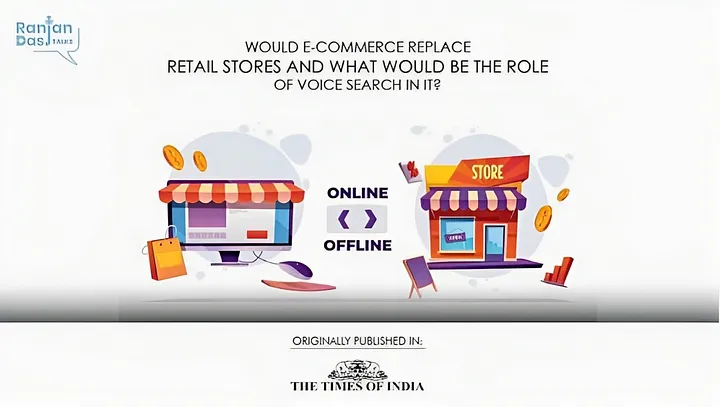
Blog
Would Ecommerce replace retail stores and what would be the role of voice search in it?
Can digital really replace the experience of pa physical store? With all such advancements, you would think how brick & mortar stores will catch up, right? But to reiterate, rise of ecommerce does

Ranjan Das
· Posted: 2022-01-06
Posted: 2022-01-06

If I told you a decades ago that soon you would be able to buy almost anything and everything online, you wouldn’t believe me. I saw it coming in 2009 while heading marketing agency Apppl Combine, shaping, launching and marketing Snapdeal, structuring the foundation days of ecommerce in India. Look where we are today! From smartphones to grocery, from apparel to cars- you get it all online, in just a few clicks. It is like a universe of its own!
Search, select, pay and wow, you have it at your doorstep and thanks to brands like blinkit in less than 10 minutes too! it really doesn’t get easier than this, does it? The ease of searching, buying and getting it delivered at your doorstep in a jiffy or during your suitable time slot has really reduced the number of times you go to a physical retail shop. And everytime you go, you often flip out your smartphone to compare the variety and offers available at various e-commerce. Does it mean that the rapidly improving e-commerce has become an undeniable benchmark, threatening the very existence of retail stores? Does it really hold the power to completely or almost completely replace physical retail? As a marketer, I am reminded of another such pressing question, heavily debated until recently that would digital media eliminate Print and TV/electronic media? The answer to such questions is possible only after deep diving into what consumers want?
Shopping has been around for almost as long as history itself and how we shop is ever-changing. Our choices, approach, behaviour, necessities and luxuries, have all evolved over time. Ecommerce and physical retail happen to be just another, but major, means of how we choose to shop. Therefore the e-commerce vs physical retail debate only seems reasonable and we must first understand the two sides and their pros and cons before concluding anything.
While e-commerce makes the buying process quicker, easier and more flexible with additional benefits like having no geographical boundaries, round-the-clock availability, more inventory etc.; physical retail stores provide instant availability of products, easier returns/replacements, assistance in buying decisions and most importantly, enabling customers to touch and feel a product. 59% of consumers say the ability to feel, touch, and try the product is key to shopping in-store vs online.
Humans are social animals and physical retail stores feed into the need of being able to have a personalised experience while shopping, but with lesser time and tighter schedules, people want convenience and ease in their lives which is facilitated by ecommerce platforms. Undoubtedly, physical retail sector has reached a more stagnant stage of growth. In 2020, Brick-and-mortar retail sales saw a 3.2% decline, which was also a result of the pandemic. Despite the dip, it remains vital and indispensable in the future. Remember queuing up in front of your neighbourhood kirana store soon after first lockdown in March — April 2020, when almost all ecommerce brands either paused their operations for many days in a stretch or were impacted heavily due to restrictions.
Infact, the future will see ecommerce and brick & mortar stores co-exist as a hybrid model, leveraging each other’s strengths. BlinkIt, previously known as Grofers, is a perfect example of how businesses today are successfully merging the benefits of ecommerce and physical retail. With its 10 minute delivery proposition, BlinkIt stocks its ‘Dark Stores’ with those fast moving 2000 products that their local retail partners suggest. This sharing of insights and knowledge base between the retail stores and the e-commerce is just one of the examples of this symbiosis, other than the popular ‘buy at ecommerce and pick it up (or exchange) at stores’ proposition and many more such examples.E-commerce sale, which was barely 13.8% of total global retail sale in 2019 is projected to rise to 24.5% by 2025 due to much higher share of sales of Fashion, Travel and Tourism, Electronic & Technology products, Medicine, Second-hand sales, Educational courses, Book and music from e-commerce as compared to physical stores. in just one decade , global ecommerce sales has jumped from $572 billion to $4.2 trillion.
Surprisingly, retail stores benefit extremely well from e-commerce. As per one of the researches, 56% of in-store purchases are influenced by the e-commerce. To keep shoppers in-store, retailers are working hard to match the experience or exceed — the ease of “point, click, buy.” To reach the price parity with ecommerce, traditional retail is exercising its pressure on brands to give them the price margin to play with and brands are more than willing to do so, realising retail is not going anywhere. In fact, reality is that I am working with large brands from electronics, fashion, iOT and construction domain, developing and realigning two lines of their product portfolios, one for traditional retail and other for the Ecommerce, ensuring they don’t miss out from the growth in both.
The amalgamation of etail and retail or as we call it, Omnichannel retailing, would make it possible for businesses to make more sales and offer better customer experience. Rather than seeing it as a threat, retailers should probably consider ecommerce as a supporting tool to serve customers better. It sounds like a win-win situation.
One of the main reasons for ecommerce growth can be attributed to the various technological advances that are providing customers with newer and easier ways to search and order products. Mobile shopping, AR, Payment Gateways, AI- assistants, Subscription Models and the list goes on. These tools and techniques are enriching the customer experience online and trying to provide a similar experience to shopping in a brick and mortar store, rather better.
Among the most recent tools being utilised by consumers, voice search is one of the most popular ones. Microsoft’s survey of 5000 US consumers found that 40% of respondents have tried to make a purchase using their voice. Type & search feature required you to be less lazy and certainly literate enough to articulate and type what you wanted. Voice search eliminates that completely. It gives a more personalised touch to the buying process and makes it more human. Just like you ask for a product in the store, you ask your AI assistant for a product, giving verbal instructions. In a research by SalesForce, at least 4 millennials out of 10 browse online before purchasing a product using voice search assistants such as Alexa, Siri, Hello Google and others.
With recent developments, the AI can now recognise different accents and languages, making the voice search more localised and personalised. The rise of voice shopping has strategic implications for retailers and consumer goods companies, and those who move quickly will reap a significant first-mover advantage. Amazon, Flipkart, Big Basket, Udaan and BuyingEngine as the early adopters to leverage from voice search. This personalised user experience will help to foster trust, reliability, transparency, validation, and control. Various brands are already up in the game, extracting the benefits of the voice technology. Nestle has initiated a cookbook feature in compliance with voice search. The online cookbook provides instructions and assistance to the questions and queries asked while cooking.
With all such advancements, you would think how brick & mortar stores will catch up, right? But to reiterate, rise of ecommerce does not mean the disappearance of physical retail from our surroundings. Infact, it’s the nature of products that will guide the mode of purchase for consumers now. Standardised products from globally trusted brands fulfil certain standards and requirements and are ‘safe’ purchases for a consumer. Therefore such purchases can be carried out online, even if it is a high investment product. For example, Apple products, H&M Apparel etc. However, a made-to-order product like a customised bridal lehenga from ‘Sabyasachi’ will be better ordered and picked up from a physical store. Groceries and other such products, however, fall somewhere in the grey area of this product classification. These cannot be completely standardised, however, concepts like- organic, homegrown, farm-fresh assure quality which lead to a certain level of benchmark being met and thus we can see etail and retail coming together to provide such products. Despite such developments, total sales of grocery online is still below 10% of total offline sales.
Ecommerce most definitely can’t eliminate retail stores from the shopping landscape because at the very fundamental level they are the roots of ‘experiancial’ shopping. However, it will definitely continue to have an accelerated trajectory in the coming decades, which will lead to a decline in physical retail, while both change shapes and forms to attract more and more sales. I think, based on best of my understanding, its safe to predict that ecommerce and retails stores will assume a symbiotic role in coming decades, leveraging each other strengths. Shopping gives a certain ‘high’ to a consumer and it needs both online and offline retail to work as stimulus and the incentive. Happy shopping.
Article is authored by Ranjan Das, MD Apppl Combine
Marketing is everything, products are
woven around it.